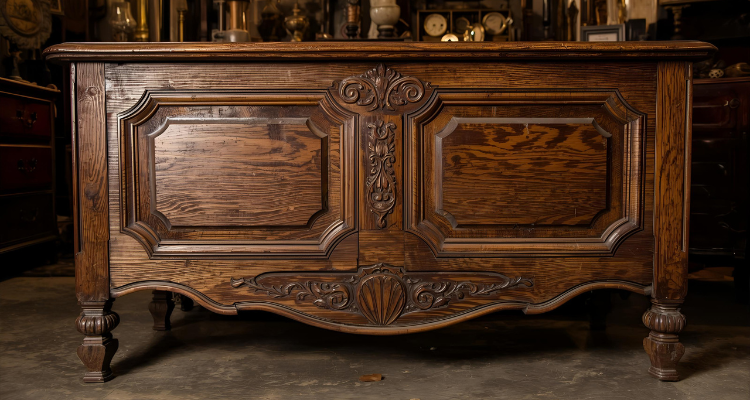In the world of early oak furniture, few pieces capture the quiet elegance of English country life quite like the oak dresser base. While the full dresser, with its upper shelves displaying pewter, china, and treasured household items, often steals the limelight, the dresser base tells a subtler, more refined story. Originally designed for storage and practical use rather than display, these pieces became a minimalist’s answer to domestic order long before minimalism was fashionable.
From Utility to Understated Beauty
In the 17th century, the oak dresser evolved as a central feature of the English farmhouse kitchen. Its upper section was typically used to display wealth through household wares, while the base, a low, sturdy chest fitted with drawers and cupboards, was the true workhorse. As space and simplicity became prized in smaller cottages and townhouses of the 18th and 19th centuries, the oak dresser base emerged as a piece in its own right.
Detached from the upper rack, it offered a neat, functional form ideal for storing linens, utensils, and tableware, while its broad surface doubled as a serving or preparation area. Craftsmen of the period understood the appeal of clean, strong lines and solid proportions. In an age before “built-in storage,” the dresser base was the practical solution for an orderly home.
The Rise of the “Base Only” Form
As rural life changed during the Georgian and early Victorian eras, and smaller dwellings replaced sprawling farmhouses, furniture became simpler. People still needed the utility of a dresser, but not the grandeur. Removing the top half not only saved space but also created a more versatile item that could fit into almost any room: a kitchen, a scullery, even a hallway.
By the early 19th century, joiners in regions such as the Welsh borders, Yorkshire, and the West Country were producing oak dresser bases as standalone items. Some were adaptations; cut-down versions of full dressers whose tops had been removed, while others were built deliberately as bases. Many retained classic regional details: the three-drawer configuration, panelled cupboards, and chamfered corners, all hewn from early oak that aged beautifully over time.
A Showcase of Local Craftsmanship
Each oak dresser base carries the distinct signature of its maker and region. For example:
- Welsh examples often have deep drawers with bold brass handles and a primitive charm.
- Yorkshire pieces tend to be longer and leaner, with subtle moulding details.
- West Country bases often feature unusual foot designs—sometimes cabriole legs or bracket feet—with wonderfully rich colour and patina.
Many early oak dresser bases were made from quarter-sawn oak, giving them the stunning medullary rays that collectors admire today. Their simplicity allowed the natural grain to shine, showing off the tactile warmth and age that only early oak can achieve.
A Minimalist’s Heirloom
Long before the concept of “minimalist design” existed, 18th- and 19th-century craftsmen created furniture that embodied its core values: simplicity, utility, and timelessness. The oak dresser base exemplifies this philosophy. An honest, unadorned form that meets every practical need while radiating quiet beauty.
Even today, collectors and interior designers prize these pieces for their adaptability. A Georgian oak dresser base looks as at home in a sleek modern interior as it does in a Tudor farmhouse. Its restrained proportions and tactile patina make it an enduring focal point, proving that true design never dates.
Unusual Facts You Might Not Know
- In some 18th-century homes, dresser bases doubled as butcher’s counters, their tough oak tops ideal for heavy work.
- In Welsh farmhouses, dresser bases were often placed beneath wall-hung shelves, creating a “modular” dresser that could be reconfigured. A remarkably modern concept.
- Some rare examples include secret drawers for valuables or silverware, often hidden behind false fronts or mouldings.
- The earliest dresser bases were sometimes built from reclaimed timbers, such as old beams or floorboards, giving them irregularities that modern reproductions can’t replicate.
The oak dresser base is far more than a piece of antique furniture. It’s a lesson in timeless design. Stripped of excess, rooted in craftsmanship, and rich in history, these early oak pieces reveal how simplicity can outlast every passing fashion. The humble oak dresser base stands as a quietly confident reminder that the best designs have always been this way. Practical, honest, and effortlessly elegant, proving that true simplicity never goes out of style.
